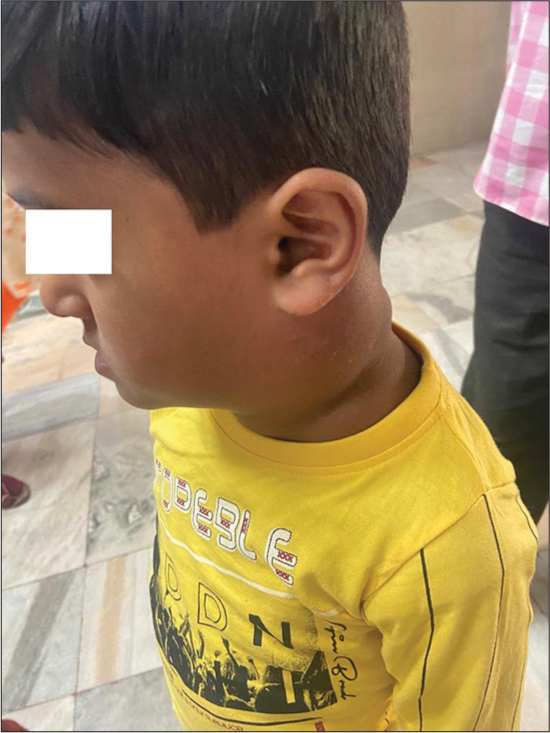Translate this page into:
A Case of Hodgkin’s Lymphoma in 5 Years Old
*Corresponding author: Shivakala Goutham Revu, Department of Cancer Registry, Rashtra Sant Tukdoji Cancer Hospital, Nagpur, Maharashtra, India. rshivakalapintoo@gmail.com
-
Received: ,
Accepted: ,
How to cite this article: Singh K, Sharma BK, Bang M, Wagh A, Revu SG. A Case of Hodgkin’s Lymphoma in 5 Years Old. Vidarbha J Intern Med. 2023;33:99-100. doi: 10.25259/VJIM_9_2023.
Abstract
Hodgkin’s lymphoma in young children is very rare. We report a case of a child of age five years who is presented with swelling over the neck with a duration of 8-month weight loss and slightly pallor. The lymph node biopsy showed Hodgkin’s lymphoma of mixed cellularity type. Immunohistochemistry was done and showed positive markers. Bone marrow was obtained and was negative. The child was referred immediately to Rashtrasant Tukdoji Regional Cancer Centre for further management and given chemotherapy. His swelling was reduced by 85%, and the child is symptomatically better without any complications.
Keywords
Hodgkin’s lymphoma
Children
Mixed cellularity subtype
INTRODUCTION
Hodgkin’s lymphoma in children is very rare. It accounts for 5–6% of all childhood cancers. The vast majority of children with Hodgkin’s lymphoma nowadays have a high chance of a definite cure. The primary goal when managing children is the cure of the child along with the presentation of late effects.
CASE REPORT
A 5-year-old male boy visited an ENT specialist with a chief complaint of swelling on the left side of the nape of the neck for an 8-month duration. The swelling around the neck measured 10 × 10 cm, which is firm and non-tender. No other swelling is seen on the rest of the body on clinical examination. He was further evaluated, and fine needle aspiration cytology (FNAC) was obtained suggestive of Hodgkin’s lymphoma then further biopsy was done suggestive of classic Hodgkin’s lymphoma-mixed cellularity type. Immunohistochemistry was further performed, and markers showed CD-15+ve, PAX+ve, EBV+ve, and Ki 67+ve. Bone marrow was obtained and was negative.
This patient visited Rashtrasant Tukdoji Regional Cancer Centre, Nagpur, on February 16, 2023, where a medical oncologist further evaluated him, and then chemotherapy was started. The tumour responded very well to the chemotherapy regimen A-Adriamycin, B-Bleomycin, V-Vinblastine sulfate and D-Dacarbazine (ABVD), and the tumour disappeared by almost 85% [Figures 1 and 2] after giving three cycles of chemotherapy, and the patient has been advised to another three cycles of chemotherapy further. The patient is alright now without any complaints or complications and is symptomatically better.

- Swelling over the left side of the nape of the neck before treatment with chemotherapy.

- Swelling reduced over the left side of the nape of the neck by 85% after treatment with three cycles of chemotherapy.
As per data, Hodgkin’s lymphoma has a good prognosis and remission rate to therapy if diagnosed early, so early diagnosis is the key, and even after relapse, they can be successfully retrieved with salvage therapy.
DISCUSSION
Hodgkin’s lymphoma in childhood has been shown to be related to various factors such as higher socioeconomic status in industrialised countries, viral infections (Epstein– Barr virus, human herpesvirus-6, and cytomegalovirus), and immunodeficiency.[1] However, the malignancy has a higher curve rate with a 5-year survival rate approaching 95%.[2] Hodgkin’s lymphoma has an overall incidence rate of 14/100000 under 15 years of age. It is a typical bimodal distribution with respect to age. Peak incidence is seen in young adults and elderly in developed countries while, in developed countries, the incidence is higher among children and young adults with male predominance.[3]
The mixed cellularity subtype of classic Hodgkin’s lymphoma occurs commonly in children and developed countries.[4]
Paediatric Hodgkin’s lymphoma commonly presents with unilateral, painless cervical lymphadenopathy, fever of 38°C, drenching night sweats, and weight loss. Management of Hodgkin’s lymphoma mostly comprises chemotherapy.
CONCLUSION
Paediatric Hodgkin’s lymphoma is increasing in developing countries. General practitioners should be aware of early symptoms and clinical manifestations. FNAC helps in initial assessment, and radiological investigation helps in disease extent. Histopathological examination helps in risk assessment and planning treatment and prognosis of disease. Hence, early diagnosis is the key in Hodgkin’s lymphoma. Overall, survival rates depend on several factors, such as the stage of cancer, the risk group of lymphoma, general health, and how well the treatment plan works.
Ethical approval
The research/study complied with the Helsinki Declaration of 1964.
Declaration of patient consent
The authors certify that they have obtained all appropriate patient consent.
Conflicts of interest
There are no conflicts of interest.
Use of artificial intelligence (AI)-assisted technology for manuscript preparation
The authors confirm that there was no use of artificial intelligence (AI)-assisted technology for assisting in the writing or editing of the manuscript and no images were manipulated using AI.
Financial support and sponsorship
Nil.
References
- Hodgkin’s Disease In: Principles and Practice of Pediatric Oncology. Philadelphia, PA: Lippincott Williams and Wilkins; 2006. p. :695-721.
- [Google Scholar]
- The Management of Children with Lymphomas. Clin Oncol (R Coll Radiol). 2013;25:11-8.
- [CrossRef] [PubMed] [Google Scholar]
- Adnexal Torsion-Management and Review of Literature. J Evol Med Dent Sci. 2014;3:2632-8.
- [CrossRef] [Google Scholar]
- Paediatric Hodgkin's Disease. Eur J Cancer. 1999;35:1466-74. discussion 1474-6
- [CrossRef] [PubMed] [Google Scholar]






